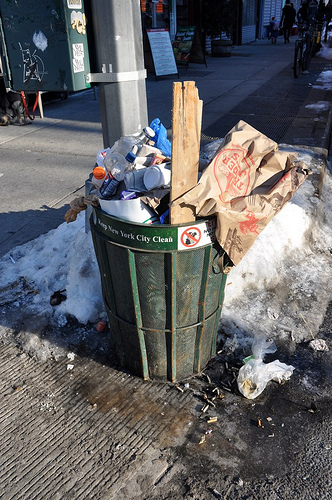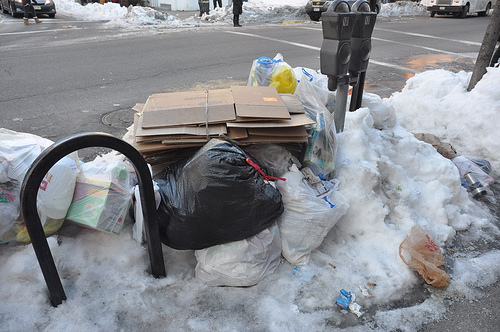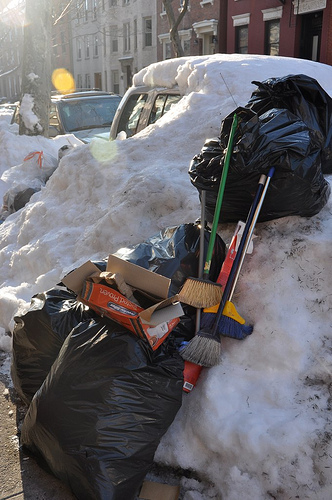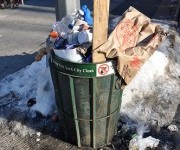 Nowhere to go.Photo: Sarah Goodyear
Nowhere to go.Photo: Sarah Goodyear
When extreme weather is in the forecast, people stock up. They storm the markets, sweep the shelves clean, and load shopping carts with bottled water, canned goods, diapers, corn flakes, milk, batteries, Pop-Tarts, you name it.
There are only three days’ worth of food on the shelves of American supermarkets at any given time. That’s the figure you hear bandied about. That’s the figure that drives the crowds to fill the carts.
With rare exceptions — Hurricane Katrina comes to mind — the crisis passes well before that three days elapses. Food deliveries resume. The shelves of the local market are once again brimful with 18 kinds of chips and 24 brands of shampoo and a perplexing array of granola bars.
Disaster averted? Don’t be so quick. In New York City, where we’ve had an unusual string of snowstorms, there hasn’t been any problem keeping the store stocked with apples from New Zealand, water from Fiji, and as many Doritos as the city can stuff in its fat face. Super Bowl partiers will be free to eat and drink to the point of oblivion.
 This belongs to all of us.Photo: Sarah GoodyearI don’t want to downplay very real concerns about food security, both short-term and long-term. But the problem in New York right now, this red-hot minute, is not too little food. It’s too much garbage.
This belongs to all of us.Photo: Sarah GoodyearI don’t want to downplay very real concerns about food security, both short-term and long-term. But the problem in New York right now, this red-hot minute, is not too little food. It’s too much garbage.
Because the Sanitation Department is also responsible for snow removal (something that did not go particularly well in the first major storm of the season), we have not had regular trash or recycling pickups since the week before Christmas.
The result, on my block and around the city, is beyond gross. Embedded in the snow drifts that have held firm for several weeks are ever-growing drifts of trash. Garbage is piled outside of people’s houses. It spills from the public waste cans that stand on many corners. At least it’s cold enough that we can’t smell it.
 Drifts of snow, drifts of trash.Photo: Sarah GoodyearDisgusting, yes, but also instructive. We worry so much about our ability to continue consuming, and almost not at all about our ability to dispose of the crap that results when our consumption is done. Now the consequences are in our face, and under our feet, and blowing around in the cold wind. There is quite literally nowhere to put it all. Many of the objects I’ve seen — clothes, furniture, household tools — would be considered still useable and valuable in much of the world. Here, they are junk.
Drifts of snow, drifts of trash.Photo: Sarah GoodyearDisgusting, yes, but also instructive. We worry so much about our ability to continue consuming, and almost not at all about our ability to dispose of the crap that results when our consumption is done. Now the consequences are in our face, and under our feet, and blowing around in the cold wind. There is quite literally nowhere to put it all. Many of the objects I’ve seen — clothes, furniture, household tools — would be considered still useable and valuable in much of the world. Here, they are junk.
When I lived in a tiny town in rural Maine back in the 1990s, the citizens still disposed of their trash by driving it up to the edge of a deep pit in the forest and throwing it into the ground. Few enough people lived there that this was possible. It seemed criminal to me, but it was perfectly legal at the time. That was the first time I realized just how permanent our refuse is.
Seeing the streets of Brooklyn fill up with black plastic bags, I think back to that dump in the beautiful Maine woods. My neighbors mostly seem to see the pile-up of junk as an inconvenience. I see it as a warning — a warning that a few municipalities, like San Francisco, are heeding. But not enough.
Let’s face it, these piles of trash are not going to make people, including me, go all No-Impact Man (although for the record, I do recycle, compost, and avoid prepackaged food).
But could we at least take a good, hard look at the evidence that is right in front of us? The proof that almost everywhere in this country, we are creating enough trash to bury ourselves?



